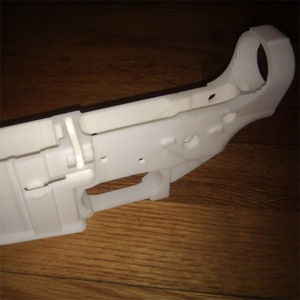 NEWS
NEWS
 NEWS
NEWS
 NEWS
NEWS
![]() Cody Wilson, a law student at the University of Texas at Austin, discovered his project to attempt to created a 3D printed gun with a leased uPrint SE 3D printer suddenly cut short when the company that leased the printer to him recalled their device. They’d heard that he intended to use the equipment to make the handgun and decided that this was too much of a liability for the company.
Cody Wilson, a law student at the University of Texas at Austin, discovered his project to attempt to created a 3D printed gun with a leased uPrint SE 3D printer suddenly cut short when the company that leased the printer to him recalled their device. They’d heard that he intended to use the equipment to make the handgun and decided that this was too much of a liability for the company.
According to an article in the New Scientist, Stratasys—manufacturer of the 3D printer Wilson was using—sent him a letter stating that they’d prefer their machine not be used in the production of any guns:
“The company is less than thrilled with what we’re doing. They’re trying to prevent me from breaking any laws with their product,” Wilson told New Scientist. With several friends, he has founded a group called Defense Distributed to promote ideas about universal gun ownership.
In a letter to Wilson, lawyers for Stratasys cited his lack of a federal firearms manufacturer’s licence as their reason for the repossession, adding that it does not knowingly allow its printers to be used for illegal purposes. Wilson countered that his group’s aim is to disseminate a printable gun design online, not print guns per se.
The project is called Defense Distributed and the letter from Stratasys is posted on their Tumblr blog.
Insofar, no guns have actually been printed by Wilson. They only exist as digital plans on computers for a 3D printer capable of working with materials capable of surviving firing. We’ve seen several different products that act as 3D printers at the consumer level, but few of them work with materials that would not deform under the high temperatures that would be produced during the ignition of bullet propellant.
We certainly anticipate that even the amazing MakerBot would not be capable of making a suitable gun product at this time; although looking at how materials science is advancing, the in-home manufacture of many parts of a gun may not be far off as the era of the physible approaches. It should also be noted, that just because someone can download the plans for and print a gun using a 3D printer, it is not necessarily illegal across most of the United States even now.
More sophisticated printers capable of fusing metals and other high temperature materials are relegated to high end machine shops—especially those that might need highly customized parts or prototype parts for unique vehicles. These machines tend to cost in the range of $800,000.
However, we have seen the technology slowly becoming more real and more affordable with the progression of the MakerBot. It’s obvious that eventually we will start to see units that could cut and fuse metal parts that might be affordable enough to sit in someone’s garage. The capability to print a firearm is only one of the many different questions that might be asked by regulatory organizations and it’s one not too unexpected even amidst sudden questions of copyright and control of physical products.
Support our mission to keep content open and free by engaging with theCUBE community. Join theCUBE’s Alumni Trust Network, where technology leaders connect, share intelligence and create opportunities.
Founded by tech visionaries John Furrier and Dave Vellante, SiliconANGLE Media has built a dynamic ecosystem of industry-leading digital media brands that reach 15+ million elite tech professionals. Our new proprietary theCUBE AI Video Cloud is breaking ground in audience interaction, leveraging theCUBEai.com neural network to help technology companies make data-driven decisions and stay at the forefront of industry conversations.